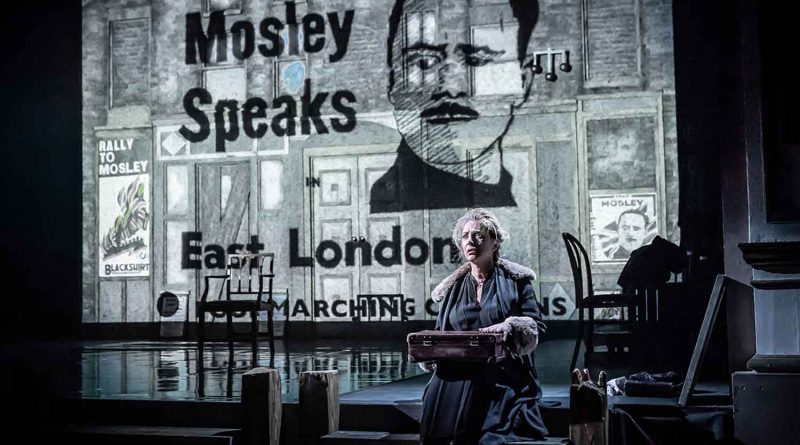The Merchant of Venice 1936 commemorates radical East End history
A new interpretation of Merchant of Venice set during the Battle of Cable Street reveals how this timeless Shakespearean play speaks to the history of the Jewish East End.
Shakespeare’s The Merchant of Venice may be a 400-year-old play set in Renaissance Italy, but this modern interpretation takes place around The Battle of Cable Street in 1936.
In November, the production is coming to Wilton’s, the 1859 music hall between Wapping and Whitechapel. In its Victorian heyday, the auditorium was fitted with a ‘sun-burner chandelier’, which beamed with 27,000 cut crystals and 300 gas jets.
Wilton’s is located in the heart of the East End, just a stone’s throw away from the historic Tower of London. The famed Grade-II listed building offers a fitting venue for this revival of The Merchant of Venice, which is told with a particularly local twist.
The theatre can be found on Graces Alley, just off Cable Street. If you wandered nine minutes east of Wilton’s, you’d come across St George’s Town Hall. On one side of the Town Hall, you may have noticed the Cable Street Mural of 1983, which commemorates a major event in East End history.
The Merchant of Venice 1936, set during the Battle of Cable Street, shines a light on a major moment of racist intolerance and radical resistance. Directed by Brigid Larmour, The Merchant of Venice 1936 commemorates the resilience and activism of the Jewish migrants of the East End.
Shakespeare’s play has been criticised by literary scholars for its antisemitic degradation of the Jewish protagonist, Shylock. Meanwhile, Larmour’s Merchant of Venice transforms Shylock into a figurehead of East End resistance.
Larmour’s revision of the play stars Tracy-Ann Oberman as a female Shylock. While Shakespeare’s Shylock ends the play as a silenced victim, Merchant of Venice 1936 places the ostracised Jewish character at the centre of a radical uprising against fascism.
By setting the early-modern play in 1936 London, Larmour’s new version of The Merchant of Venice spotlights a key moment in British history, reminding us of the violent threat of fascism against migrant communities.
In Shakespeare’s original, Antonio, an antisemitic merchant, asks the Jewish moneylender Shylock for a loan of 3000 ducats – the Italian currency of the time. After Antonio finds himself unable to pay Shylock back, Shylock monstrously demands a pound of Antonio’s flesh as revenge.
In a trial in the court of Venice, Shylock is punished for having attempted to take the life of a citizen. By the end of the play, Shylock is dispossessed: the Venetians take control of his property, he is forced to abandon Judaism and convert to Christianity, and his daughter Jessica abandons him.
In Larmour’s adaptation, Antonio, Shylock’s enemy, is an aristocratic fascist. Played by Raymond Coulthard, Antonio is an officer in the British Union of Fascists, ‘a movement which got an awful lot of support from the aristocracy in England in the 1930s’, according to the actor.
Oberman’s Shylock is a working-class Jewish matriarch, who fled violent anti-Jewish pogroms in the Russian Empire to find safety in the East End. The character is based upon Oberman’s great-grandmother, Annie, who escaped to England from her village in Russia after witnessing her father being violently assaulted in a pogrom.
Gráinne Dromgoole, who plays Shylock’s daughter Jessica, said:
‘Shylock is based quite closely on really tough women who came over to the UK and had to carve out their lives, and who didn’t assimilate very easily.
‘The Shylock of this play in 1936 has a pawn shop on Cable Street. She’s a tough immigrant, a single mother who’s raising a daughter and is a widow.’
Today, Cable Street is home to a large South Asian community. After the Independence of Bangladesh in 1971, a large amount of Bangladeshis migrated to the East End. The Bangladeshi community worked in the rag trade of Brick Lane and Cannon Street Road, which cuts across Cable Street.
Meanwhile, in the early 20th century Cable Street was home to a large population of Jewish migrants. Between 1881 and 1914, two million Jewish people migrated from Eastern Europe, 150, 000 of whom relocated to Britain according to the Jewish Museum.
By the 1930s, a distinct Jewish community had formed in London’s East End. While the Jewish migrants were safe from antisemitic pogroms in the Russian Empire, threats remained in Britain.
During the Great Depression, anti-Jewish sentiment spread in England as Jewish people were blamed for the harsh economic climate. On 4 October 1936, thousands of members of the BUF, led by Oswald Mosley, marched through the Jewish community of the East End.
The BUF, also known as the Blackshirts, intended to intimidate the Jewish population.
About the events on Cable Street in 1936, Dromgoole said:
‘There’s so much propaganda that has come out of The Second World War about the idea that Britain is innately anti-fascist because we defeated the Nazis, but it was never destined to happen that way.
‘It’s important to know that fascism recurs in British history and we have to be on guard against it.’
While Shylock is an isolated victim of anti-Jewish sentiment in Shakespeare’s original, Shylock of Merchant of Venice 1936 is a key player in the victory of the Battle of Cable Street.
When thousands of Blackshirts marched through East End streets in March 1936, they were confronted with 200,000 anti-fascist protestors. British Jews united with communists, trade unionists, Irish dockers, and the Afro-Caribbean community in solidarity against fascism.
As Dromgoole states, British Jews played a ‘massive’ role in the anti-fascist demonstration. Before the march, The Jewish People’s Council gathered the signatures of 100,000 East Londoners in a petition calling for Mosley’s march to be banned.
The Merchant of Venice 1936 celebrates this radical moment of solidarity in East London. The successful anti-fascist protest led to the Public Order Act in 1937, banning the public wearing of political uniforms. It also triggered the creation of the Stepney Tenants’ Defence League, which campaigned against rising rents.
By returning to this moment in time, Larmour pays homage to the resilient immigrant community of East London, which continues to fight back against vicious racism.
Another key character is Portia (Hannah Morrish), who in this production is loosely based on Diana Mitford, a British fascist and aristocrat who married Mosley. Ten actors share the stage for what promises to be two hours of conflict and precarious resolution.
By the time the Cable Street Mural was painted in 1983, few Jewish people still lived in Stepney. The mural celebrates those present at the Battle of Cable Street in 1936, as well as the South Asian community which emerged in the 1960s and 1970s.
After immigrating to the East End, Bengalis experienced racism from The National Front, a fascist political party founded by A. K. Chesterton, a former Blackshirt.
The battle of Cable Street might have taken place over 80 years ago, but The Merchant of Venice 1936 highlights how the fight against racism continues.
The play contains a valuable lesson: the Blackshirts were only defeated due to the collective power of diverse communities. Larmour’s play uses East End history to remind us that in the battle against oppression, there’s strength in unity.
The Merchant of Venice 1936 runs at Wilton’s Music Hall from 7-11 November. For tickets, visit merchantofvenice1936.co.uk.
For more about the history of protests in our local area, read ‘Never mind their fingers’: the strikers who bled for the East End.

